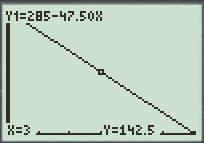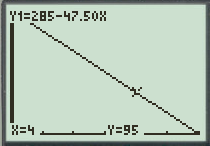
Concept explainers
(a)
To find: The linear equation that gives the dollar value V of the MP3 player in terms of the year t .
(a)
Answer to Problem 30RE
The linear equation that gives the dollar value V of the MP3 player in terms of the year t is equal to V(t)=285−47.50t .
Explanation of Solution
Given information:
The dollar value of an MP3 player in 2015 is $285 . The product will decrease in value at an expected rate of $47.50 per year.
Calculation:
As the initial value of MP3 player in 2015 i.e. t=0 is $285 and the value of MP3 player decrease at an rate of $47.50 per year.
The decrease in value of MP3 player for t years is $47.50t and the value of MP3 player after t years is equal to 285−47.50t .
Therefore, the linear equation that gives the dollar value V of the MP3 player in terms of the year t is equal to V(t)=285−47.50t .
(b)
To graph: The equation found in part(a) in appropriate window for the graph and state its dimensions of the viewing window.
(b)
Answer to Problem 30RE
The dimensions of the viewing window are [0,6] by [0,285] as the intercepts for the equation are 6 and 285 .
Explanation of Solution
Given information:
The dollar value of an MP3 player in 2015 is $285 . The product will decrease in value at an expected rate of $47.50 per year.
Calculation:
To graph a function V(t)=285−47.50t , follow the steps using graphing calculator.
First press “ON” button on graphical calculator, press Y= key and enter right hand side of the equation y=285−47.50t after the symbol Y1 . Enter the keystrokes 285−47.50X .
The display will show the equation,
Y1=285−47.50X
Press the WINDOW key and adjust the window by [0,6] by [0,285] .
Now, press the GRAPH key and TRACE key to produce the graph of given quadratic equation in standard window as shown in Figure (1).

Figure (1)
These dimensions are chosen as the intercepts formed by the line are 6 and 285 .
(c)
To find: The dollar value of MP3 player in 2019 with the help of trace key and confirm the answer algebraically.
(c)
Answer to Problem 30RE
The dollar value of MP3 player in 2019 is equal to $95 .
Explanation of Solution
Given information:
The dollar value of an MP3 player in 2015 is $285 . The product will decrease in value at an expected rate of $47.50 per year.
Calculation:
To graph a function V(t)=285−47.50t , follow the steps using graphing calculator.
First press “ON” button on graphical calculator, press Y= key and enter right hand side of the equation y=285−47.50t after the symbol Y1 . Enter the keystrokes 285−47.50X .
The display will show the equation,
Y1=285−47.50X
Press the WINDOW key and adjust the window by [0,6] by [0,285] .
Now, press the GRAPH key and TRACE key to produce the graph of given quadratic equation in standard window as shown in Figure (1).
Now enter the keystrokes 2ndTRACE1 and then enter the value of X=4 as X=4 represents the year 2019 .

Figure (1)
So, the dollar value of MP3 player in 2019 is equal to $95 .
Confirm the answer algebraically.
Substitute 4 for t in the function for value as t=4 represents the year 2019 .
V(t)=285−47.50tV(4)=285−47.50(4)V(4)=285−190V(4)=95
Therefore, the dollar value of MP3 player in 2019 is equal to $95 .
(d)
To find: The year when the MP3 player will not have value.
(d)
Answer to Problem 30RE
The year when the MP3 player will not have value is 2021 .
Explanation of Solution
Given information:
The dollar value of an MP3 player in 2015 is $285 . The product will decrease in value at an expected rate of $47.50 per year.
Calculation:
As observed from the graph in part(b), the function of value touches the x -axis at x=6 .
So, the MP3 player has 0 value at x=6 .
The value x=6 corresponds to the year 2021 .
Therefore, the year when the MP3 player will not have value is 2021 .
Chapter 1 Solutions
Precalculus with Limits: A Graphing Approach
- 5. The graph of ƒ is given below. Sketch a graph of f'. 6. The graph of ƒ is given below. Sketch a graph of f'. 0 x 7. The graph of ƒ is given below. List the x-values where f is not differentiable. 0 A 2 4arrow_forward2. DRAW a picture, label using variables to represent each component, set up an equation to relate the variables, then differentiate the equation to solve the problem below. The top of a ladder slides down a vertical wall at a rate of 0.15 m/s. At the moment when the bottom of the ladder is 3 m from the wall, it slides away from the wall at a rate of 0.2 m/s. How long is the ladder?arrow_forwardPlease answer all questions and show full credit pleasearrow_forward
- please solve with full steps pleasearrow_forward4. Identify at least two mistakes in Francisco's work. Correct the mistakes and complete the problem by using the second derivative test. 2f 2X 2. Find the relative maximum and relative minimum points of f(x) = 2x3 + 3x² - 3, using the First Derivative Test or the Second Derivative Test. bx+ bx 6x +6x=0 12x- af 24 = 0 x=0 108 -2 5. Identify at least three mistakes in Francisco's work. Then sketch the graph of the function and label the local max and local min. 1. Find the equation of the tangent line to the curve y=x-2x3+x-2 at the point (1.-2). Sketch the araph of y=x42x3+x-2 and the tangent line at (1,-2) y' = 4x-6x y' (1) = 4(1) - 667 - 2 = 4(-2)4127-6(-2) 5-8-19-20 =arrow_forward۳/۱ R2X2 2) slots per pole per phase = 3/31 B=18060 msl Ka, Sin (1) Kdl Isin ( sin(30) Sin (30) اذا ميريد شرح الكتب بس 0 بالفراغ 3) Cos (30) 0.866 4) Rotating 120*50 5) Synchronous speed, 120 x 50 S1000-950 1000 Copper losses 5kw 50105 Rotor input 5 0.05 loo kw 6) 1 1000rpm اذا ميريد شرح الكتب فقط Look = 7) rotov DC ined sove in peaper PU + 96er Which of the following is converge, and which diverge? Give reasons for your answers with details. When your answer then determine the convergence sum if possible. 3" 6" Σ=1 (2-1) π X9arrow_forward
- 1 R2 X2 2) slots per pole per phase = 3/31 B = 180 - 60 msl Kd Kol, Sin (no) Isin (6) 2 sin(30) Sin (30) اذا ميريد شرح الكتب بس 0 بالفراغ 3) Cos (30) 0.866 4) Rotating 5) Synchronous speed; 120*50 Looo rem G S = 1000-950 solos 1000 Copper losses: 5kw Rotor input: 5 loo kw 0.05 1 اذا میرید شرح الكتب فقط look 7) rotor DC ined sove in pea PU+96er Q2// Find the volume of the solid bounded above by the cynnuer 2=6-x², on the sides by the cylinder x² + y² = 9, and below by the xy-plane. Q041 Convert 2 2x-2 Lake Gex 35 w2x-xབོ ,4-ཙཱཔ-y √4-x²-yz 21xy²dzdydx to(a) cylindrical coordinates, (b) Spherical coordinates. 201 25arrow_forwardshow full work pleasearrow_forward3. Describe the steps you would take to find the absolute max of the following function using Calculus f(x) = : , [-1,2]. Then use a graphing calculator to x-1 x²-x+1 approximate the absolute max in the closed interval.arrow_forward
- (7) (12 points) Let F(x, y, z) = (y, x+z cos yz, y cos yz). Ꮖ (a) (4 points) Show that V x F = 0. (b) (4 points) Find a potential f for the vector field F. (c) (4 points) Let S be a surface in R3 for which the Stokes' Theorem is valid. Use Stokes' Theorem to calculate the line integral Jos F.ds; as denotes the boundary of S. Explain your answer.arrow_forward(3) (16 points) Consider z = uv, u = x+y, v=x-y. (a) (4 points) Express z in the form z = fog where g: R² R² and f: R² → R. (b) (4 points) Use the chain rule to calculate Vz = (2, 2). Show all intermediate steps otherwise no credit. (c) (4 points) Let S be the surface parametrized by T(x, y) = (x, y, ƒ (g(x, y)) (x, y) = R². Give a parametric description of the tangent plane to S at the point p = T(x, y). (d) (4 points) Calculate the second Taylor polynomial Q(x, y) (i.e. the quadratic approximation) of F = (fog) at a point (a, b). Verify that Q(x,y) F(a+x,b+y). =arrow_forward(6) (8 points) Change the order of integration and evaluate (z +4ry)drdy . So S√ ² 0arrow_forward
 Calculus: Early TranscendentalsCalculusISBN:9781285741550Author:James StewartPublisher:Cengage Learning
Calculus: Early TranscendentalsCalculusISBN:9781285741550Author:James StewartPublisher:Cengage Learning Thomas' Calculus (14th Edition)CalculusISBN:9780134438986Author:Joel R. Hass, Christopher E. Heil, Maurice D. WeirPublisher:PEARSON
Thomas' Calculus (14th Edition)CalculusISBN:9780134438986Author:Joel R. Hass, Christopher E. Heil, Maurice D. WeirPublisher:PEARSON Calculus: Early Transcendentals (3rd Edition)CalculusISBN:9780134763644Author:William L. Briggs, Lyle Cochran, Bernard Gillett, Eric SchulzPublisher:PEARSON
Calculus: Early Transcendentals (3rd Edition)CalculusISBN:9780134763644Author:William L. Briggs, Lyle Cochran, Bernard Gillett, Eric SchulzPublisher:PEARSON Calculus: Early TranscendentalsCalculusISBN:9781319050740Author:Jon Rogawski, Colin Adams, Robert FranzosaPublisher:W. H. Freeman
Calculus: Early TranscendentalsCalculusISBN:9781319050740Author:Jon Rogawski, Colin Adams, Robert FranzosaPublisher:W. H. Freeman
 Calculus: Early Transcendental FunctionsCalculusISBN:9781337552516Author:Ron Larson, Bruce H. EdwardsPublisher:Cengage Learning
Calculus: Early Transcendental FunctionsCalculusISBN:9781337552516Author:Ron Larson, Bruce H. EdwardsPublisher:Cengage Learning





